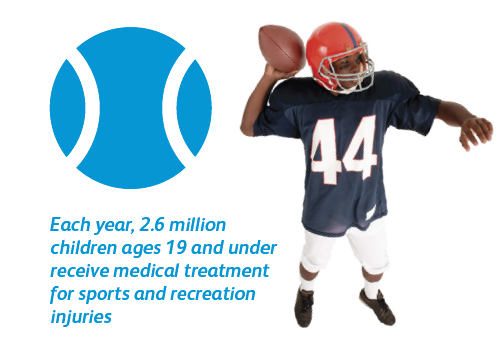Brain Injury Prevention: Changing the culture is key
Sharing is caring!
March is Brain Injury Awareness Month, take a moment to learn more about how to prevent a brain injury to yourself or someone you care about.
What is a Traumatic Brain Injury?
A traumatic brain injury (TBI) is defined as a blow or jolt to the head or a penetrating head injury that disrupts the function of the brain. Not all blows or jolts to the head result in a TBI. The severity of such an injury may range from “mild,” i.e., a brief change in mental status or consciousness to “severe,” i.e., an extended period of unconsciousness or amnesia after the injury. A TBI can result in short or long-term problems with independent function.
Did you Know?
- Traumatic brain Injury (also referred to as TBI) is the leading cause of disability and death in adults and children 1-44
- They most often result from motor vehicle accidents, sports injuries, falls on the playground, at work or at home
- Currently, 2% of the U.S. population lives with a disability as a result of a traumatic brain injury
- Males are 2x more likely than females to have a TBI
- African Americans have the highest death rates from TBIs
- TBIs can change the way people process emotions, way of thinking, and language communication
- TBI’s can be reduced through use of helmets, education, and safety measures!
Prevention is Key
Follow these tips to reduce the risk of brain injury:
- Seat belts and airbags. Always wear a seat belt in a motor vehicle. A small child should always sit in the back seat of a car and be secured in child safety seats or booster seats that are appropriate for his or her size and weight.
- Alcohol and drug use. Don’t drive under the influence of alcohol or drugs, including prescription medications that can impair the ability to drive.
- Helmets. Wear a helmet while riding a bicycle, skateboard, motorcycle, snowmobile or all-terrain vehicle. Also wear appropriate head protection when playing baseball or contact sports, skiing, skating, snowboarding, or riding a horse.
The following tips can help younger children avoid head injuries:
- Install safety gates at the top of a stairway
- Keep stairs clear of clutter
- Install window guards to prevent falls
- Put a nonslip mat in the bathtub or shower
- Use playgrounds that have shock-absorbing materials on the ground
- Make sure area rugs are secure
- Don’t let children play on fire escapes or balconies
- More sport safety prevention tips HERE…
Personal Story
“I hope my story will help raise awareness about the dangers of concussions and educate other young athletes so that they know what to look out for.”
My name is Steve Oswald and I’m from Bucks County, Pennsylvania. Two years ago, when I was a junior in high school, I got a concussion while playing baseball.
I’ve loved baseball ever since I was a little kid. I will always remember my first experience hitting and throwing a baseball at the park with my dad. From the time I was 5 years old, I played on an organized tee ball team and became hooked. The only thing I ever thought about was baseball. I would practice almost every single day.
One day I remember going out back to practice my swing. I couldn’t find any baseballs lying around so I thought the next best thing would be a metal fence post. I took my brand new bat and swung it as hard as I could at that fence, not knowing that it was an absolutely awful idea. At my next game my dad asked me, “Stephen, why are there so many dents in your bat?” and I innocently replied, “I was practicing my hitting, aren’t you proud of me?” He could only look at me and laugh. I’ve played baseball ever since – 13 years and counting. Some of my best memories involve baseball. But one day that all changed.
It was the last practice of the season during my junior year and the last occasion for my team to be on the field until spring, so I was really excited and giving it my all. Our coach split us up into two separate teams and we scrimmaged each other with live pitching, throwing, running, and hitting. Tracking down long fly balls and throwing people out at the bases is what I love to do. And that day, I was in the perfect position for it; I was playing right field.
All we needed was one more out to finish the game. I knew that if the ball was hit anywhere near me, I had to catch it. The pitcher wound up and threw the pitch, the batter swung and I watched a high, lazy floater coming in my direction. I sprinted as fast as I could to the ball and I knew that I was going to catch it, but what I didn’t know is that my teammate was thinking the same thing. He was playing second base at the time so the ball was bound to land between us. I sprinted, dove for the ball and felt it hit my glove. A split second later, I heard an indescribable sound that I will never forget.
My teammate’s knee struck me in the face – hard – just under my left eye. All I can remember from the impact is an intense pain. I rolled on the ground and noticed people gathering all around me. My head was pounding, my nose was bleeding, my face was aching, and I had a sick feeling in my stomach. I was not in good shape.
My coach called my mom and we left immediately for the hospital, where I had a series of x-rays taken. The doctor said I sustained multiple fractures in my face and that I needed surgery to fix it. The doctor also said I might have a concussion, but at the time, we didn’t think much of it, because we were trying to focus on healing my face.
Two days later, I was back in the hospital in the operating room where a surgeon inserted three metal plates and 16 titanium screws in my face that I can feel under my skin to this day. I had regular check-ups with the ear, nose and throat doctor to make sure that everything was going smoothly and there were no complications. The swelling and bruising went down after a month and I was making great progress.
When I went back to school after two weeks of recovery, I had a great deal of work to catch up on. All through high school, I was a straight-A student. But that fall semester, I was really struggling. I had trouble paying attention in class. When I’d try to read or write, I’d feel this intense pain in my forehead.
I didn’t notice it at first but I found it even harder to concentrate on my work than I did before the injury. I couldn’t read more than one sentence in a textbook without losing my place or forgetting what I had just read. Copying notes from a presentation or from the white board was one of the most difficult tasks.
Every day after school I would be so exhausted from my classes that I would nap for at least two hours. I just wasn’t myself and I couldn’t figure out why. It was frustrating because I knew that I could do better and I was disappointed in myself.
In December, as part of training for the baseball team, I took a course about concussions sponsored by Safe Kids Worldwide. It was facilitated by our athletic trainer and a health professional from the community. As I listened to the trainer describe the signs and symptoms of a concussion a light bulb went off in my head.
Headaches? Check.
Nausea? Check.
Tired and sleeping too much? Check.
Difficulty concentrating? Check.
That was me. Listening to trainer, I realized in that moment that I had a concussion.
My concussion was inhibiting me from working to my full potential and being the best I could be. I was so upset because my schoolwork is important to me and I wasn’t sure how long the concussion effects were going to last.
Together with my parents, the school athletic trainer, the school counselor and a neurologist, we developed a detailed program to treat my concussion. Slowly, I started back on the road to better grades, normal life and baseball. By spring, I recovered well enough to return to baseball. It felt amazing to be back on the field again. And this year, I started college at Penn State University, where I am working hard and am symptom free.
Since my injury, I tell my story to as many people as possible. I hope it will help raise awareness about the dangers of concussions and educate other young athletes so that they know what to look out for. Most of all, I hope my experience can prevent other people from suffering the same thing I did.
Sources: Neurologic Rehabilitation Institute// BrainLine.org//Mayo Clinic
Join us on Facebook



